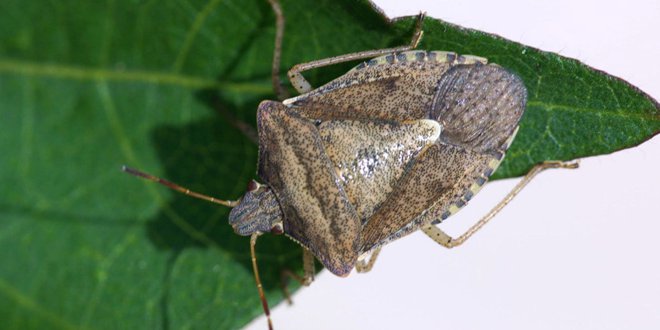There have been many stories on the news the past couple of years about the stink bug invasion. Most people have known about stink bugs for years and never knew they were actually a pest until recently when the numbers of native pest-type stink bugs and a new wave of foreign bugs have caused major problems for thousands of farmers and property owners. What are stink bugs, and why are they such horrible pests?

What is a Stink Bug?
Stink bugs are proper bugs, meaning that they are six-legged invertebrates with sucking mouthparts called rostrums. Stink bugs belong to the genus Pentatomidae, which has 4700 sub-species, 250 of which call North America home. They are characterized by their shield-shaped bodies and pointed rear ends. The name “stink bug” comes from the fact that they have a set of scent glands between their two front sets of legs. These release a foul-smelling chemical that discourages predators. When frightened, stink bugs emit this powerful smell, which makes getting rid of stink bugs difficult.
What Do They Eat?
Stink bugs eat various things depending on which species they belong to. Some are completely harmless and actually beneficial: the Florida stink bug and several other varieties actually eat other pest-type insects such as caterpillars and grubs that eat plants. However, the majority of stink bugs are herbivores. They use their rostrums to pierce the juicy stems and fleshier parts of plants and fruit to suck out sap and juices, resulting in the plant dying or fruit rotting. These herbivorous stink bugs seem to especially love sweet things, such as corn, tomatoes, peaches, and other fruit.
What Do They Do?
Stink bugs aren’t colonial insects like ants and bees they don’t build nests or hives. They tend to travel by themselves, but when a stink bug population begins to grow due to unseasonably warm temperatures, for instance, they will encounter each other and tend to gravitate toward the same areas. Stink bugs love warmth and light and are drawn to it, which is why they tend to come inside when the seasons change—they’re searching for shelter. Once inside they find out-of-the-way places to congregate and breed, such as in attics, basements, crawl spaces, and other such areas these are some facts about stink bugs.

Why the Sudden Problem?
Most people think of them as outdoor insects that aren’t much of an irritation unless you bother them. Farmers have a lower opinion based on occasional stink bug population spikes which have led to wholesale crop losses in the past. Those spikes normally fall off quickly. However, in the past several years a new type of stink bug, the brown marmorated species, has been found in the U.S. in growing numbers. It is a fast breeder and a voracious eater of many cash crops.
What Next?
The combination of odd temperatures the country has seen in recent years and the development of the marmorated stink bug have resulted in the increasing numbers that people are seeing. Stink bugs have always been around, but the severe winter temperatures have driven them indoors in larger numbers than ever before since they like to “overwinter” indoors. Since they carry no diseases and don’t bite they don’t pose a health hazard. People are advised to do what they can to keep them outside and use the right pesticide outdoors.
Stink bugs are an almost-humorous insect plague—until you have one of your own. Thousands of homeowners last year were frantic, as were fruit and other crop farmers all over the region. Common sense approaches to dealing with stink bugs are the best such as you can assist team from Pest Control Geelong for removal of these bugs, as well as a big dollop of patience.







